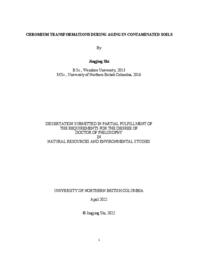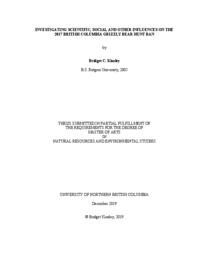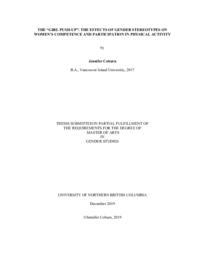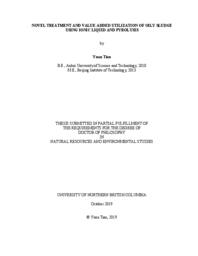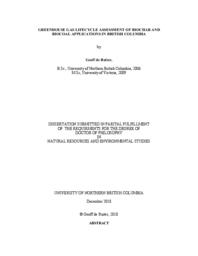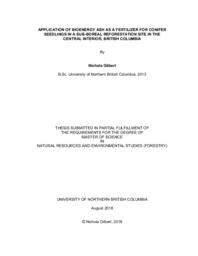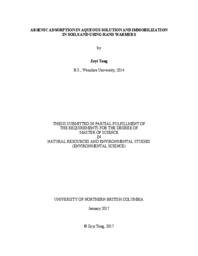McGill, William B.
Person Preferred Name
William B. McGill
Related Works
Content type
Digital Document
Description / Synopsis
Extensive industrial activities have led to Cr contamination in the environment, which poses threats to ecosystems and human health. Currently, very little is known regarding the Cr accumulation in soils during aging. The purpose of this dissertation was (i) to enhance our understanding of Cr transformations occurring over a long period of time; (ii) to investigate the reduction of toxic Cr(VI) to non-toxic Cr(III) by soil microorganisms for developing bioremediation strategies for Cr-contaminated sites. Soil samples were collected from a longterm (> 30 years) tannery waste contaminated area in Shuitou (China) for this research. Chemical extraction methods showed the Cr(III) form was dominant (> 96.7% of total Cr) in these aged Cr-contaminated soils, with toxic Cr(VI) up to 144 mg kg-1. Of the total Cr(VI) present, immobile Cr(VI) represented > 90%. Synchrotron-based X-ray near edge structure spectroscopy demonstrated Cr species present were CrFeO3, CrOOH, and CaCrO4. The occurrence of immobile Cr(VI) species in long-term contaminated soils was further verified by a spiking experiment over 240-day aerobic incubation. Available Cr(VI) in soils continually decreased during aging, with immobile Cr(VI) increasing by 4.5 – 31% and immobile Cr(III) increasing by 68 – 95% of total spiked Cr(VI). These findings reveal that Cr(VI) reduction and immobilization were occurring concurrently in soils. Cr(VI) reduction occurs in soils with low pH and high organic carbon content via both chemical and biological processes, while Cr(VI) immobilization occurs in soils with cations (such as Ca2+) and Fe oxides. Shotgun metagenomic sequencing was used to analyze the microbial community composition in the soils and a batch solution experiment was employed to determine the Cr(VI) reduction capacity by soil microbial consortia. The results demonstrated the accumulation of high levels of Cr in a soil (e.g., 3141 mg kg-1 in S3-2) led to the increased abundance of Cr resistant and reducing microorganisms: Proteobacteria (69.9%) at phylum level, Betaproteobacteria (39.1%) at class level, and Massilia (12.6%) and Bacilli (0.57%) at genus level. Batch experiment results showed the addition of 1.0 g Cr-contaminated soils reduced 10 – 20 mg L-1 Cr(VI) in 20 mL of K2Cr2O7 solution at the condition of 30 oC at pH 7.8 – 8.0 within 7 days anaerobically and aerobically, when supplied with 0.2 g L-1 of Na-acetate as carbon and electron sources. The amount of Cr(VI) removed was highest (29.0 mg L-1) at 40 mg Cr(VI) L-1 in the presence of soil S3-2. Therefore, prospective application of mixed microbial consortia from high Cr-contaminated soils for bioremediation of Cr(VI)-polluted environments could be expected.
Origin Information
Content type
Digital Document
Description / Synopsis
Background: The prevalence of Alzheimer’s disease (AD) and other dementias is perpetually increasing in Canada and worldwide with the aging baby boomer population. It is, therefore, important to identify risk factors for these major neurocognitive disorders, such as alcohol consumption, to mitigate the future burden on caregivers and the economy. The purpose of this study was to replicate previous research regarding the dose-response relationship between alcohol consumption and the odds of currently having AD or another dementia. The possibility of a sex effect moderating this relationship was also explored. Participants: Data were obtained for respondents to the combined 2015/16 cycles of the Canadian Community Health Survey who were aged 41 years or older at the time of the survey’s conduction (nweighted = 16,715,618). Methods: Logistic regression was used to crossectionally assess the relationship between various time- and frequency-related alcohol consumption exposures to outcome dementia status, while controlling for a number of demographic and risk factor variables. Results: A sex effect was identified for drinking at an average frequency of four to six times per week over the past year (p = 0.019, 95% CI: 0.03, 0.73) where women (ORw = 0.13) were more protected against currently having AD or dementia than men (ORm = 0.89) when compared to alcohol abstainers. Binge drinking two to three times per month (OR = 0.19, p = 0.015, 95% CI: 0.05, 0.73) and more than once per week over the past year (OR = 0.16, p = 0.007, 95% CI: 0.04, 0.61) significantly lessened the odds of currently having AD or dementia when compared against alcohol abstainers. A sex effect was present for those who were classified as very heavy drinkers (♂: 6+ drinks/day, ♀: 4+ drinks/day) over the past week (p = 0.018, 95% CI: 1.14, 39.41) where alcohol was protective against currently having AD or dementia in men (ORm = 0.29) and alcohol was a risk factor for currently having AD or dementia in women (ORw = 2.15) when both were referenced with alcohol abstainers. Conclusions: With the exception of very heavy drinker women, drinking alcohol was associated with a reduced likelihood of currently having AD or dementia and sex effects were identified for drinking at a moderate frequency over the past year and very heavy drinkers. However, these results should be interpreted with caution due to the possibility of selection, sparse data, and abstainer biases as well as misclassification error. The primary implication of this research is to inform future studies that a more thorough exploration of a sex effect influencing the relationship between alcohol consumption and having AD or dementia is warranted.
Origin Information
Content type
Digital Document
Description / Synopsis
British Columbia has the largest grizzly bear population in Canada. In 2017, B.C. banned the hunt of grizzly bears citing a lack of societal support, despite government-cited science that the hunt was sustainably managed. I explored the factors that influenced popular perceptions of grizzly bears, the hunt, how these factors may have influenced the province’s decision to implement the ban, and its reception by various actors. Methods included: examining key claims in government documents preceding the ban; surveying media coverage of the ban; and interviewing experts (n = 30) about their role in, and opinion of the ban. Results indicated that public perception of the hunt, and its framing as a trophy hunt outweighed scientific evidence of hunt sustainability. However, controversy over the representativeness of the “public opinion”, and comprehensiveness of government consultation processes remain. I suggest avenues for further research into roles of social values in natural resource policy.
Origin Information
Content type
Digital Document
Description / Synopsis
Men are stereotyped as more physically competent than women. The stereotyping of women’s poor performance creates the conditions for stereotype threat. Stereotype threat, the fear of confirming a stereotype, can undermine women’s performances and participation in sports. Stereotype threat, however, has not been tested in strength-building activities. The present study experimentally tests whether stereotype threat undermines women’s willingness to perform unmodified push-ups and undermines their push-up performance. Women were assigned to four conditions: a stereotype-threat condition, an implicit stereotype-threat condition, a relief condition, and a control condition. Under stereotype threat, women were expected to choose modified over unmodified push-ups and, among those performing unmodified push-ups, to complete fewer push-ups than women in the other conditions. These hypotheses were not supported. During debriefings, women described their experiences related to push-ups and strength training. A thematic analysis of women’s debriefings offers insight into the gender complexities of women’s engagement with strength training.
Origin Information
Content type
Digital Document
Description / Synopsis
The effective treatment of oily sludge has been a challenging problem faced by the petroleum industry worldwide. It is a semi-solid mixture of hydrocarbons, water, metallic ions, and suspended fine solids. The recalcitrant nature of oily sludge makes the treatment a difficult and costly task. The objective of this dissertation research was to develop environmentally friendly and economically competitive techniques for oily sludge treatment. Three different approaches were developed: ionic liquid (IL)-enhanced solvent extraction, co-pyrolysis with wood waste, and value-added utilization of oily sludge as sorbent to remove lead (Pb2+) and cadmium (Cd2+) from solution. Firstly, as compared to conventional solvent extraction, the IL-enhanced solvent extraction not only improved oil recovery efficiency but also greatly reduced solvent and energy consumption as well as shortening the treatment duration even at low IL concentration. Secondly, co-pyrolysis of oily waste and hog fuel was conducted in a fixed bed reactor. Three experimental parameters (pyrolysis temperature, reaction time, and hog fuel addition) were explored to optimize both oil recovery and metal ion immobilization. The latter was tested through sequential extraction techniques with high temperature pyrolysis leading to metal ions fixed within the residues. The addition of hog fuel had a significant synergistic effect on the distribution of metal ions in the various extraction fractions resulting in lower risk index (RI) values. Thirdly, the oily sludge-derived char (OS500) obtained at 500 °C could effectively remove Pb2+ from solution with the maximum sorption capacity of 373.2 mg/g (based on a Langmuir model). Sorption of Pb2+ by the OS500 was mainly attributed to its precipitation with carbonate (CO32‒) originating in OS500. The maximum sorption capacity for Cd2+, using a Langmuir model, was 23.19 mg/g. Complexation and metal ion exchange dominated Cd2+ sorption on OS500. The Pb2+ sorption capacity dramatically decreased as the iii pyrolysis temperature increased from 500 to 900 °C due to the decomposition of minerals which could release CO32‒ at high temperature. The activated OS500 showed a higher sorption capacity (90.06 mg/g) for Cd2+ than OS500 (23.95 mg/g) because conversion of barite (BaSO4) to witherite (BaCO3) after chemical activation favored the precipitation of Cd-carbonate.
Origin Information
Content type
Digital Document
Description / Synopsis
Biochar, a form of black carbon produced from pyrolyzed biomass, has been touted as a product that may suppress agricultural soil emissions while also sequestering carbon. BC Biocarbon LTD, a recently established company in McBride, BC, has developed a method of producing a new product called biocoal. This biocoal is produced from a combination of crushed biochar and an organic-based binder also made from the original biomass feedstock. As their biocoal contains similar properties to fossil coal or petroleum coke, its use to reduce emissions as an energy fuel or sequestration method may be favourable to biochar’s use as a soil additive. Additionally, this biocoal may present a method of long-term carbon sequestration if buried. This dissertation assessed the greenhouse gas emissions from the production of biocoal from BC Biocarbon’s system and compared the results to wood pellet production and delivery (Project 1), coal and petroleum coke displacement (Project 2), landfilling for carbon sequestration, while also assessing biochar’s potential soil greenhouse gas reductions with added carbon sequestration (Project 3), and a regional and province-wide assessment for reducing emissions in BC using available sawmill and roadside slash residues (Project 4). Project 1 showed that when comparing biocoal made from sawmill residues to locally produced wood pellets, transportation emissions may be decreased 64% due to biocoal’s higher heating value. When comparing emissions produced for biocoal or wood pellets at gate, biocoal may show a 42% reduction in emissions or up to a 51% increase in emissions, however this is largely dependent on the data-sourced scenarios and their underlying assumptions of emissions allocation. Project 2 showed that displacing petroleum coke in cement kilns offered the largest reduction potential compared to coal applications such as electricity generation, or lead smelting. Project 3 showed that under 3 average conditions, sequestering biocoal offered greater emission reduction potential than soil applied biochar. Finally, Project 4 showed that an estimated GHG emission reduction or carbon sequestration of 28,000,00 Mg CO2e/year from current available residues, and 20,006,000 Mg CO2e/year in 10 years’ time, BC has the potential to reduce its current emissions by around 46%, and 33% in 10 years.
Origin Information
Content type
Digital Document
Origin Information
Content type
Digital Document
Origin Information
Content type
Digital Document
Origin Information
Content type
Digital Document
Origin Information

